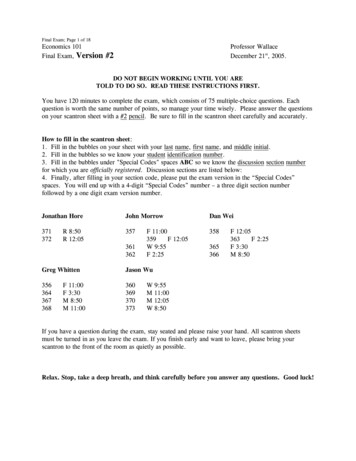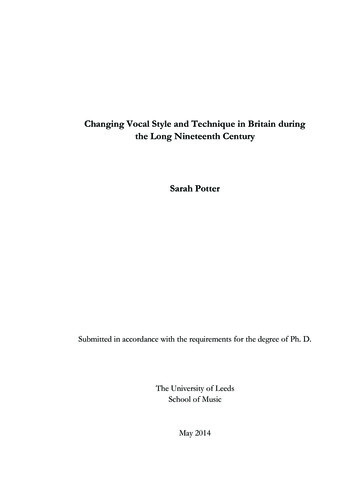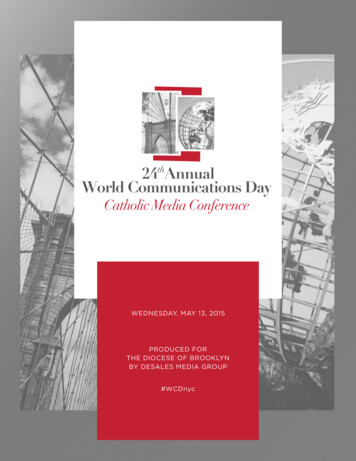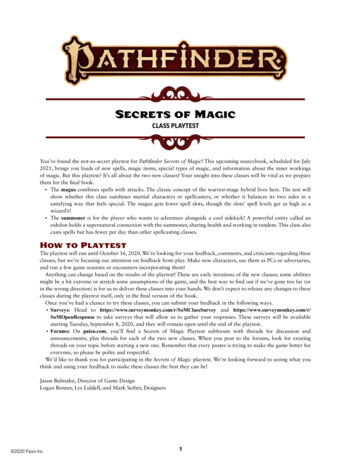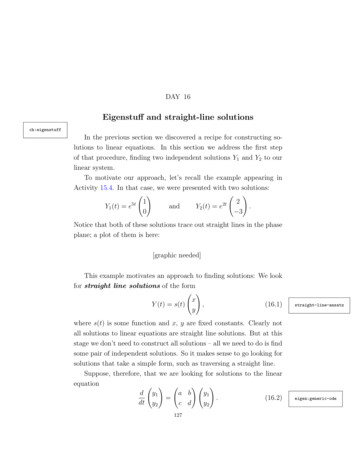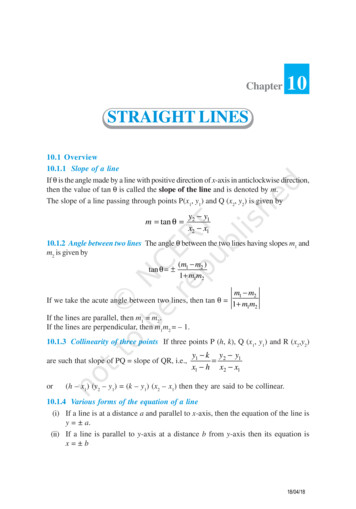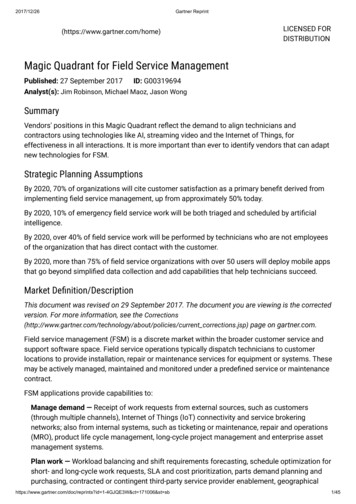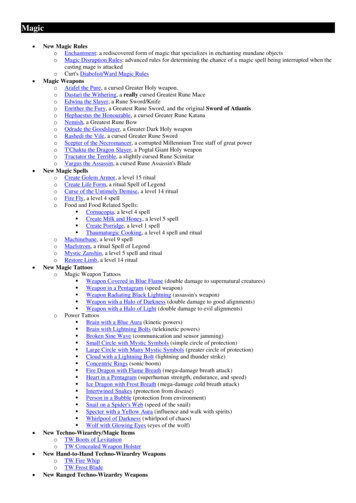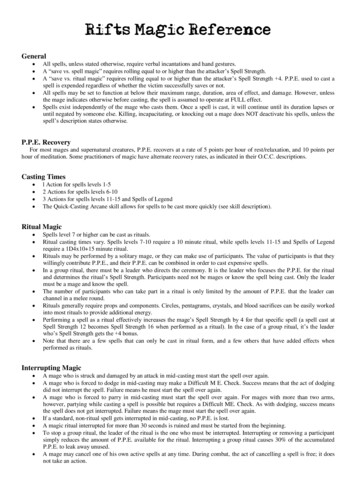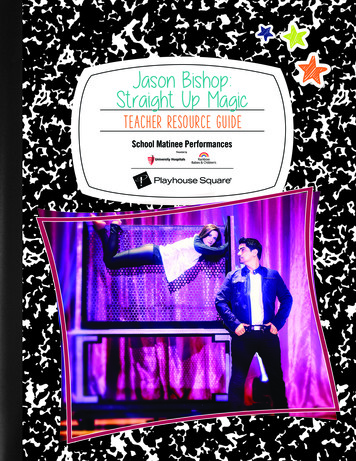
Transcription
Jason Bishop:Straight Up MagicTEACHER RESOURCE GUIDESchool Matinee Performances
Teacher Resource GuideJASON BISHOP: STRAIGHT UP MAGICTABLE OF CONTENTSAbout Playhouse Square3Coming to the Theater4About the Show5Pre-Show Activities6Post-Show Activities9Curriculum Standards Index12COMMUNITY ENGAGEMENT& EDUCATIONThe lessons and activities in this guide are driven by theOhio Learning Standards (2017) in English Language Arts,Fine Arts and Science.21st century skills of creativity, critical thinking andcollaboration are embedded in the process of bringing thepage to the stage. Seeing live theater encourages studentsto read, develop critical and creative thinking skillsand to be curious about the world around them.This Teacher Resource Guide includes backgroundinformation, questions and activities that can standalone or work as building blocks toward the creationof a complete unit of classroom work.The Ohio Arts Council helps fund this organization with state tax dollars to encourageeconomic growth, educational excellence and cultural enrichment for all Ohioans.Playhouse Square is supported in part by the residents of Cuyahoga County through apublic grant from Cuyahoga Arts & Culture.2playhousesquare.org/eduresources
ABOUT PLAYHOUSE SQUAREPlayhouse Square is an exciting field trip destination!As the country’s largest performing arts center outsideof New York, the not-for-profit Playhouse Square attractsmore than one million guests to 1,000 shows and eventseach year. Five of Playhouse Square’s 11 performancespaces are historic theaters that first opened in the early1920s. By the late 1960s, they had been abandoned. Agroup of volunteers saved the theaters from being turnedinto parking lots. Now, all five historic theaters are fullyrestored.You’ll find Broadway, concerts, comedy, dance andfamily shows on Playhouse Square’s stages, alongwith performances by Playhouse Square’s six : Cleveland Ballet, Cleveland Play House,Cleveland State University’s Department of Theatre andDance, DANCECleveland, Great Lakes Theater andTri-C JazzFest.When you visit, be sure to check out the GE Chandelier,the world’s largest outdoor chandelier, and the retroPlayhouse Square sign with its 9-foot-tall letters!
Coming to the TheaterWe look forward to welcoming you and your studentsto Playhouse Square! To prepare for a successful fieldtrip, we encourage you to spend some time discussingthe differences between coming to the theater andwatching a television show or movie or attending asporting event, especially if you have students whohave not yet had the opportunity to attend a livetheater performance. Here are a few points to startthe discussion:Y ou and your students will be greeted and helped toyour seats by members of Playhouse Square’s staffand “RedCoat” volunteers.T heaters are built to magnify sound. Even theslightest whisper can be heard throughout thetheater. Remember that not only can those aroundyou hear you, the performers can too.A s you watch the performance, feel free to respondby laughing or applauding.F ood, drink and gum are not permitted in the theaterfor school matinee performances.4playhousesquare.org/eduresourcesP hotography and recording of performances are notpermitted.M obile phones and other devices that make noise orlight up should be silenced and put away before theperformance begins.W hen the houselights dim, the performance is about tobegin. Please turn your attention toward the stage.A fter the performance, a member of the PlayhouseSquare staff will come out on stage to dismiss eachschool group by bus number. Check around your seatto make sure you have all of your personal belongingsbefore leaving.
ABOUT THE SHOWAs America’s hottest illusionist, Jason Bishop might readyour mind one second or make goldfish appear the next.Known for his virtuosity and versatility of magic genres,Jason cleverly combines traditional magic with moderntechnology and prides himself on his ability to performboth rare illusions and the fundamentals of magic.Each performance of Jason’s exclusive grand illusionsand elegant, agile sleight-of-hand magic are deliveredwith Bishop’s wry wit and engaging audienceparticipation. From his stunning Double Levitation,new Hologram Illusion starring Gizmo the dog, to theastonishing close-up magic that is captured live andprojected onto large screens, Jason gives the audiencea clear view of every detail. Intelligent lighting togetherwith countless costume changes by his skillful assistantKim and a rock and pop soundtrack make this atheatrical experience you will not forget!About JasonJason Bishop is an international award-winning illusionistwho was the youngest person to win the Magician’sAlliance of Eastern State Stage Award and one of theyoungest people to compete in the Society of AmericanMagicians World-Class competition.Jason’s interest in magic ran throughout his youth. Bornin Fleetwood, Pennsylvania, Jason was a foster childfrom the age of seven until eighteen. As a young personhe spent much of his time reading books about magic,thus sparking his interest and life-long journey as amagician and illusionist. Jason’s first paid performancewas for the foster care agency he was a part of as ayoung person. In college Jason studied theatre and thenwent on the road performing at resorts, amusementparks and later colleges.Jason has entertained celebrities like Jennifer Aniston,Chris Penn and Bam Margera, who after seeing hisperformance said “Jason Bishop is the best magicianI’ve ever seen.” His performance abilities have led himfrom California to Maine and Florida to New York, aswell as every state in-between and over 20 countries in4 continents.5playhousesquare.org/eduresourcesAbout KimAs Jason’s lead assistant, Kim Hess is an indispensablepart of the show. From performing illusions with Jason toassisting audience members, to knowing the show cuesinside and out, Kim is a vital part of the show’s success.Born in Reading, Pennsylvania, Kim began studying theperforming arts at a very young age. At four years oldshe had an experience that absolutely changed her life.At the suggestion of a family member, Kim’s mother tookher to a local baton twirling production unit. Kim stayedwith that group for more than nineteen years. In that timeshe won well over one hundred awards, among themwere first place trophies from the National/World BatonConference held at Notre Dame University. During thoseyears, Kim also studied dance and gymnastics and wasa captain of her high school cheerleading squad. Withher fun and warm personality, her striking looks andconsiderable talent, Kim is an irreplaceable member ofthe Jason Bishop team!
PRE-SHOWACTIVITIESDo You Believe in Magic?The Ohio Learning Standards listed below are addressedin the following Pre-Show Activity:CCR.W.2.3, CCR.W.3.3, CCR.W.4.3, CCR.W.5.3,CCR.W.6.3, CCR.W.7.3, CCR.W.8.31. You decide to become an amateur magician, doingtricks like guessing someone’s card and sawingwomen in half! What are some of the tricks that youdo? What happens at your very first magic show?Most kids are excited to see a magic show. JasonBishop is actually an illusionist. An illusionist is a typeof magician. Whereas magicians focus on tricks usingsmall items such as cards, illusionists use large objectsto entertain a crowd - for example, sawing a person inhalf in a large box. Prior to the show, have your studentsrespond to one of these two prompts:OR:6playhousesquare.org/eduresources1. Do you think magic exists? Why or why not? If you dobelieve in it, where do you think it came from? If youdon’t believe in it, go into detail about why you thinkthat it is made up.
Duck! RabbitThe Ohio Learning Standards listed below are addressedin the following Pre-Show Activity:CCR.RL.K.1, CCR.RL.1.1, CCR.RL.2.1Before the show, ask your students if they believe thateverything they see is real. Start a classroom discussionand encourage your students to elaborate on each otherviewpoints. After your discussion, read the book Duck!Rabbit! to your students. A read aloud version of thebook is available on YouTube https://www.youtube.com/watch?v 36AqMX5uua4&t 7s.Show the book cover to your students and ask themwhat they see. How many students see a duck? Arabbit? Both? Neither? Have them explain why they seewhat they see. Ask them who is right? Or is everyoneright? As you read the book, periodically stop and askyour students if what they saw at the beginning is stillwhat they see. At the end of the story, ask your studentsif they see an anteater or a er reading the book, explain to your students thatthis image is an optical illusion. The object that they arelooking at is tricking them into seeing something thatisn’t there.Provide them with another example of an optical illusionby showing them the picture below and asking themhow many legs the elephant has:Is the picture playing tricks on their eyes? Explain tothem that when they watch Jason Bishop perform histricks, he is really performing optical illusions. He istricking their eyes into seeing something that isn’t there.
Do You See What I See?The Ohio Learning Standards listed below are addressedin the following Pre-Show Activity:Visual Arts K.4PR, 1.4PR, 2.3PR, 3.4PR, 4.2PR, 5.4PROptical Illusions can be really fun to look at, but they canbe really frustrating too – remember the blue and blackdress? Or was it white and gold? This activity allowsstudents to explore different optical illusions beforetrying to make their own. Begin by showing students theimage below.Ask them what they see. Some will see two faces, whileothers will see a candlestick. Have a second copy ofthis image ready with the candlestick (white portion)colored in. Show students this second version. Arepeople who were only able to see the two faces able tosee the candlestick now? Are those who could only seethe candlestick able to see the two faces now?Use this website to show students additional examplesof optical illusions https://www.optics4kids.org/illusions.After going through several illusions, tell your studentsthat they are going to try to make their own opticalillusions.Materials:8.5 in. x 11 in. white paperSharpie markersPencil crayons1. Start by drawing a curved line across the paper with aSharpie marker. Think rolling hill not roller coaster!2. Add 8 dots across the line. They should be differentlengths apart. You need a dot close to the edges ofyour paper.3. Start connecting the dots with bumps. The lines fromthe dots close to the edge will go off the edge of thepaper to an imaginary dot.4. The lines will eventually go off the top and bottom ofthe paper.5. Fill the whole paper.6. Pick a group of colors you feel work well together (2or 3).7. Using pencil crayons, fill in the spaces. Press harderin the corners. As you get near the top of each bump,press lighter and lighter.8. Continue until the work is complete.When students are finished, have them swap illusions.8playhousesquare.org/eduresources
POST-SHOW ACTIVITYA Magician’s Secrets RevealedPart I: MagnetsThe Ohio Learning Standards listed below are addressedin the following Post-Show Activity:1.PS.2, 2.PS.1, 3.PS.3, 4.PS.2, 7.PS.4, 8.PS.1make one by using a ball of Playdough and sticking apencil in it. Challenge the students and see if they canmake a magnet float. Once they figure out how to makeit float, ask them what is happening to make the magnetfloat (the magnets are repelling each other).Magicians and illusionists often use magnets as one wayto make things levitate, or float. Tell your students thatthey, too, can make objects float.Then ask them to think about Jason Bishop’s StraightUp Magic show. Did Jason make any objects float? Didhe “magically” pull objects towards him? Give students afew moments to see if they can make the connection ontheir own that Jason was using magnets to help objectsfloat or to pull objects towards himself.Give students several ring magnets and have them playwith them for a few moments. As students are playingwith their magnets, have them make observations. Askthem if they can make magnets “push” each other. Canthey make them “pull” each other?Provide the following chart to your students for them todocument their observations.After a few moments, give them a magnet stand. If youdon’t have a magnet stand (see picture above), you canFloating MagnetsJason BishopDraw a diagram showing how you made your magnetsfloat.Think back to a magic trick that Jason did that made anobject float. Draw a diagram that might explain how hemade that object float.9playhousesquare.org/eduresources
A Magician’s Secrets RevealedPart II: mirrorsTaken -catThe Ohio Learning Standard listed below is addressed inthe following Post-Show Activity:5.PS.2Disappearing acts are often very dramatic andmemorable parts of magic shows. Once you know thescience behind the magic trick, it isn’t as impressive.Magicians understand the way light bends and moves.They use their knowledge to their advantage, and theyhave added mirrors to their bag of tricks. There are manyways that magicians use mirrors to make people andobjects disappear. This is one method and it is simpleenough for your students to try for themselves.To Do and NoticeSit so that a white surface or wall is on your right andhave a partner sit a few feet in front of you. Hold thebottom of a mirror with your left hand and put the mirroredge against your nose so that the reflecting surface ofthe mirror faces sideways, toward the white surface.While keeping the mirror edge against your nose, anglethe mirror so that your right eye sees just the reflectionof the white wall, while your left eye looks forward at yourpartner’s face (see diagram). Move your hand in front ofthe white surface as if passing a blackboard eraser overthe surface. Watch as parts of your friend’s face disappear.It will help if your partner is sitting very still against aplain, light-colored background. You should also try tokeep your own head as still as possible.If you have trouble seeing your partner’s face disappear,one of your eyes might be stronger than the other. Trythe experiment again, but this time switch the eye youuse to look at the person and the eye you use to lookat the wall. (You and your partner may have to switchplaces so the white wall is to your left. Position the mirroragainst your nose so your left eye sees the reflection onthe wall and your right eye is looking at your partner.Then wave your left s vary greatly in their ability to perceive thiseffect. You may have to try several times, and a fewpeople may never succeed in observing it. Don’t give uptoo soon! Give yourself time to see the effect.What’s Going On?Normally, your two eyes see very slightly differentpictures of the world around you. Your brain analyzesthese two pictures and then combines them to create asingle, three-dimensional image.Here, the mirror lets your eyes see two very differentviews. One eye looks straight ahead at another person,while the other eye looks at the white wall or screen andyour moving hand. Your brain tries to put together apicture that makes sense by selecting bits and piecesfrom both views.Your brain is very sensitive to changes and motion.Because the other person is sitting very still, your brainemphasizes the information coming from your movinghand, rather than the unmoving face. As a result, partsof the person’s face disappear. No one knows how orwhy some parts of the face may remain, but the eyesand mouth seem to be the last features to disappear.After students have had a chance to practice makingtheir partner disappear, have them think back to JasonBishop and the tricks that he did. Are there any that hemay have used mirrors to make objects disappear?
houdiniThe Ohio Learning Standards listed below areaddressed in the following Post-Show Activity:CCR.RI.K.3, CCR.RI.1.3Long before Jason Bishop was born, another famousmagician toured the United States and Europe. Hisname was Harry Houdini. Read the story A Picturebook of Harry Houdini by David A. Adler, and MichaelS. Adler to your students. After reading the story,have your students answer these questions aboutHarry Houdini.Who was Harry Houdini?What did Harry Houdini do?How is Harry Houdini similar toJason Bishop?How is Harry Houdini different fromJason Bishop?Write or draw something that youfound interesting about HarryHoudini.Write or draw something that youfound interesting about HarryHoudini.11playhousesquare.org/eduresources
CURRICULUM STANDARDS 1With prompting and support, ask and answerquestions about key details in a text.KDuck! Rabbit!7Visual ArtsK.4PRReduce objects into basic shapes and lines in relationto the whole image.KDo You See WhatI See?8CCR.RI.K.3With prompting and support, describe the connectionbetween two individuals, events, ideas, or pieces ofinformation in a text.KHoudini11CCR.RL.1.1Ask and answer questions about key details in a text.1Duck! Rabbit!7Visual Arts1.4PRCreate an artwork based on observation of familiarobjects and scenes.1Do You See WhatI See?81.PS.2Objects can move in a variety of ways, such asstraight, zigzag, circular and back and forth.1A MagiciansSecrets RevealedPart I: Magnets9CCR.RI.1.3Describe the connection between two individuals,events, ideas, or pieces of information in a text.1Houdini11CCR.W.2.3Write narratives to recount a well-elaborated event orshort sequence of events, include details to describeactions, thoughts, and feelings, use temporal words tosignal event order, and provide a sense of closure.2Do you Believe inMagic?6CCR.RL.2.1Ask and answer such questions as who, what, where,when, why, and how to demonstrate understanding ofkey details in a text.2Duck! Rabbit!7Visual Arts2.3PRCreate artworks based on imagination and observationof familiar objects and scenes2Do You See WhatI See?82.PS.1Forces change the motion of an object.2A MagiciansSecrets RevealedPart I: Magnets9CCR.W.3.3Write narratives to develop real or imaginedexperiences or events using effective technique,descriptive details, and clear event sequences.3Do you Believe inMagic?6Visual Arts3.4PRCreate artworks that demonstrate awareness of twoand three- dimensional space.3Do You See WhatI See?812playhousesquare.org/eduresources
CURRICULUM STANDARDS t, electrical energy, light, sound and magneticenergy are forms of energy.3A MagiciansSecrets RevealedPart I: Magnets9CCR.W.4.3Write narratives to develop real or imaginedexperiences or events using effective technique,descriptive details, and clear event sequences.4Do you Believe inMagic?6Visual Arts4.2PRExperiment with art materials by using them inunexpected and creative ways to express ideas andconvey meaning4Do You See WhatI See?84.PS.2Energy can be transferred from one location to anotheror can be transformed from one form to another.4A MagiciansSecrets RevealedPart I: Magnets9CCR.W.5.3Write narratives to develop real or imaginedexperiences or events using effective technique,descriptive details, and clear event sequences.5Do you Believe inMagic?6Visual Arts5.4PRSelect and use the elements and principles of artand design to communicate understanding of aninterdisciplinary concept5Do You See WhatI See?85.PS.2Light and sound are forms of energy that behave inpredictable ways.5A MagiciansSecrets RevealedPart II: Mirrors10CCR.W.6.3Write narratives to develop real or imaginedexperiences or events using effective technique,relevant descriptive details, and well-structured eventsequences.6Do you Believe inMagic?6CCR.W.7.3Write narratives to develop real or imaginedexperiences or events using effective technique,relevant descriptive details, and well structured eventsequences.7Do you Believe inMagic?67.PS.4Energy can be transferred through a variety of ways.7A Magician’sSecrets RevealedPart I: Magnets9CCR.W.8.3Write narratives to develop real or imaginedexperiences or events using effective technique,relevant descriptive details, and well-structured eventsequences.8Do you Believe inMagic?68.PS.1Objects can experience a force due to an external fieldsuch as magnetic, electrostatic, or gravitational fields.8A Magician’sSecrets RevealedPart I: Magnets913playhousesquare.org/eduresources
this image is an optical illusion. The object that they are looking at is tricking them into seeing something that isn t there. Provide them with another example of an optical illusion by showing them the picture below and asking them how many legs the elephant has: Is the picture

